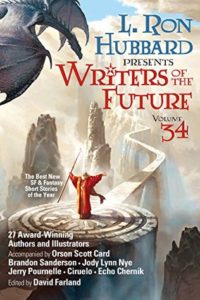Book Review: Writers of the Future, Volume 34 edited by David Farland
Disclaimer: I received a download of this book through a Goodreads giveaway for the purpose of writing this review. No other compensation was offered or requested.
Back before he became involved with…you know, L. Ron Hubbard was a prolific author of stories for pulp magazines, including some for the science fiction category. In the 1980s, he decided to give back to the field (and self-promote) by creating a contest to find exciting new writers in science fiction, fantasy and horror. Thus, the Writers of the Future competition.
Each quarter, three submissions from hundreds win the chance to be featured in an annual compilation volume. In addition, a set of Illustrators of the Future compete to be able to present a picture based on one of the stories. This is the 34th such volume, which is frankly amazing.
The introduction goes over some of the selection process, including that since these volumes may be appearing in school libraries, excessive violence, explicit sex scenes and rough language will usually knock a story out of consideration. (Some of these stories come very close to the line.) Next, there’s a description of how the Illustrators of the Future contest works.
The stories themselves open with “Turnabout” by Erik Bundy, about a traveler who discovers that he is owed one wish by a djinn. He realizes she is under no obligation not to twist his wish, but what if he can grant her a twisted version of the djinn’s own desire? Note: there’s an ethnic slur used, but I think the author is well-meaning.
The final story is “All Light and Darkness” by Ami Henri Gillett. An AWOL super-soldier attempts to blend in with a stream of refugees, but finds himself getting too involved with two of them, young siblings. At the same time, he struggles with his own abandonment issues. There’s some musings on what makes a person human.
In between are a number of other stories, and essays on writing and art from past and current contest judges. (Mr. Hubbard may have left this mortal coil, but he is very much a presence here.)
Standouts include “The Minarets of An-Zabat” by Jeremy TeGrotenhuis, about a junior bureaucrat in an empire that absorbs all magical schools into its own or destroys those it cannot tame. He becomes fascinated by the wind-calling natives who are the last major holdouts against the Empire’s hegemony.
Also “Mara’s Shadow” by Darci Stone, an effective blend of horror and science fiction. In the near future, a Vietnamese researcher happens to be called in to the first known case of a human being eaten from the inside out by moth larvae. We follow her story as this becomes a worldwide pandemic, with flashbacks to how this all got started about a century before. Content warning: there are multiple suicides in this story.
My black and white Kindle does make most of the illustrations less effective, which is a particular shame for Jazmen Richardson’s illustration of N.R.M. Roshak’s “A Bitter Thing.” This tale of a young human’s relationship with a color-shifting alien relies very heavily on colors as a central theme, and the resulting picture doesn’t work in monochrome.
The one exception is Ven Locklear’s illustration for “Death Flyer” by L. Ron Hubbard. This chiller about a ghost train lends itself to an evocative picture that works just fine in grayscale.
The cover story reverses the process, with Jody Lynn Nye writing “Illusion” to match Ciruelo’s painting Dragon Caller. A court wizard is in fact just an illusionist, but when his country is invaded, he must come up with a plan to defend it against very real enemies. It’s a clever story.
Overall, this is a decent enough collection of stories by writers you probably haven’t heard of before (plus Hubbard and a lesser piece by Brandon Sanderson) but at least some of whom you’re likely to hear of in the near future. Check it and previous volumes out at your library!

